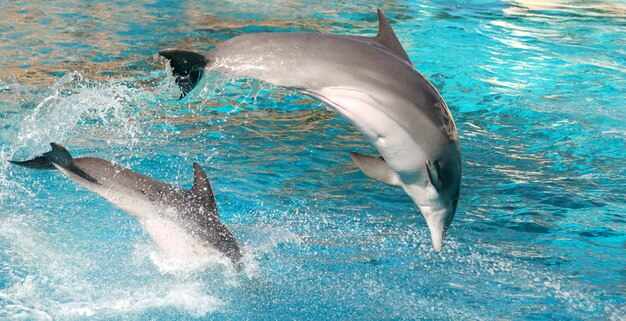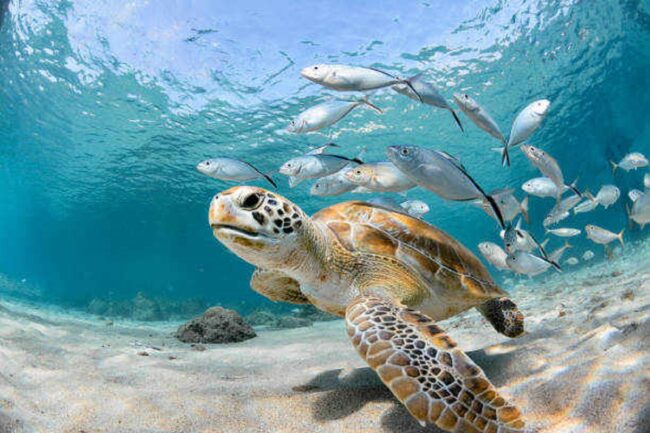What Does It Mean When Dolphins Swim Around You?
Introduction
Dolphins, renowned for their intelligence and social behavior, are among the most intriguing creatures of the marine world.
Their interactions with humans, particularly their tendency to swim close, have captivated and intrigued people for generations.
This article delves into the various reasons behind this fascinating behavior. So, let’s dive in and explore the secrets of dolphins swimming around humans!
The Curiosity Factor
One of the primary reasons for dolphins swimming around humans is curiosity.
These intelligent creatures are known to be curious about their surroundings, especially when they encounter something new or unusual.
When they come across humans in the water, they often swim closer to get a better look and satisfy their curiosity. It’s similar to how we would approach a friendly dog on the street out of curiosity.
Social Interaction
Dolphins are incredibly social animals and live in large groups called pods. They form strong bonds within these pods, and their social interactions play a vital role in their daily lives.
When they encounter humans, they may perceive them as part of their pod and attempt to interact with them.
This social behavior is seen in dolphins raised in captivity, where they often seek out human company for social interaction.
Dolphins’ Curiosity
Dolphins are naturally curious animals, a trait evident in their behavior both within their pods and when encountering other species.
Their intelligence drives them to explore their surroundings, leading them often to approach humans.
This curiosity is not just a passive observation; dolphins have been known to closely inspect boats, divers, and swimmers, displaying a keen interest in understanding these unfamiliar visitors to their aquatic world.
So, it’s not surprising that they would swim around humans to get a better understanding of them and satisfy their curiosity.
The Intelligent Connection
Dolphins are one of the most intelligent animals on the planet, with complex social behaviors, communication skills, and problem-solving abilities.
This high level of intelligence enables them to recognize humans as fellow intelligent beings and form connections with them.
Their curiosity and social nature further fuel this desire to interact with humans, as they see us as potential sources of information and companionship.
Playful Nature of Dolphins
Playfulness is a hallmark of dolphin behavior. These marine mammals engage in games, acrobatics, and interactive play both within their groups and with other species, including humans.
Swimmers and divers frequently report dolphins initiating games or mimicking their movements, showcasing a joyful and spirited side of these aquatic mammals.
Dolphins Seeking Human Help
Remarkably, there are documented instances where dolphins have actively sought help from humans.
Cases where dolphins, entangled in fishing nets or injured by hooks, approach boats and divers for assistance highlight their awareness and potential trust in human capability for aid.
These interactions are profound, demonstrating an interspecies communication and understanding that is rare in the wild.
Protective Behavior of Dolphins
Dolphins have occasionally displayed protective behavior towards humans.
There are anecdotal accounts of dolphins forming protective circles around swimmers to fend off sharks, suggesting an instinctual desire to protect not only their kind but other species as well.
While it’s challenging to conclusively understand the motivation behind such behavior, these acts of altruism are heartwarming and highlight the complex social structures and empathy dolphins possess.
Human Impact on Dolphin Behavior
The interaction between humans and dolphins is not without its concerns. Human activities, such as boating and fishing, can negatively impact dolphins’ natural habitats and behavior patterns.
Therefore, humans must interact responsibly with these intelligent creatures, ensuring their wild nature is respected and preserved.
Interactions between Dolphins and Humans
Dolphins are known for their playful and social nature, which has led to numerous documented interactions between them and humans.
These exchanges, whether initiated by dolphins or humans, are often positive and highlight the unique bond that can exist between two species.
However, it’s crucial to remember that these interactions should always occur on the dolphins’ terms, with their well-being as a top priority.
Conclusion
The reasons why dolphins swim around humans are as multifaceted as the creatures themselves.
From curiosity to playfulness, seeking help to protective instincts, these interactions tell a story of complex intelligence and social structures.
Understanding these reasons not only deepens our appreciation of dolphins but also underscores the importance of coexisting responsibly with the remarkable inhabitants of our oceans.







